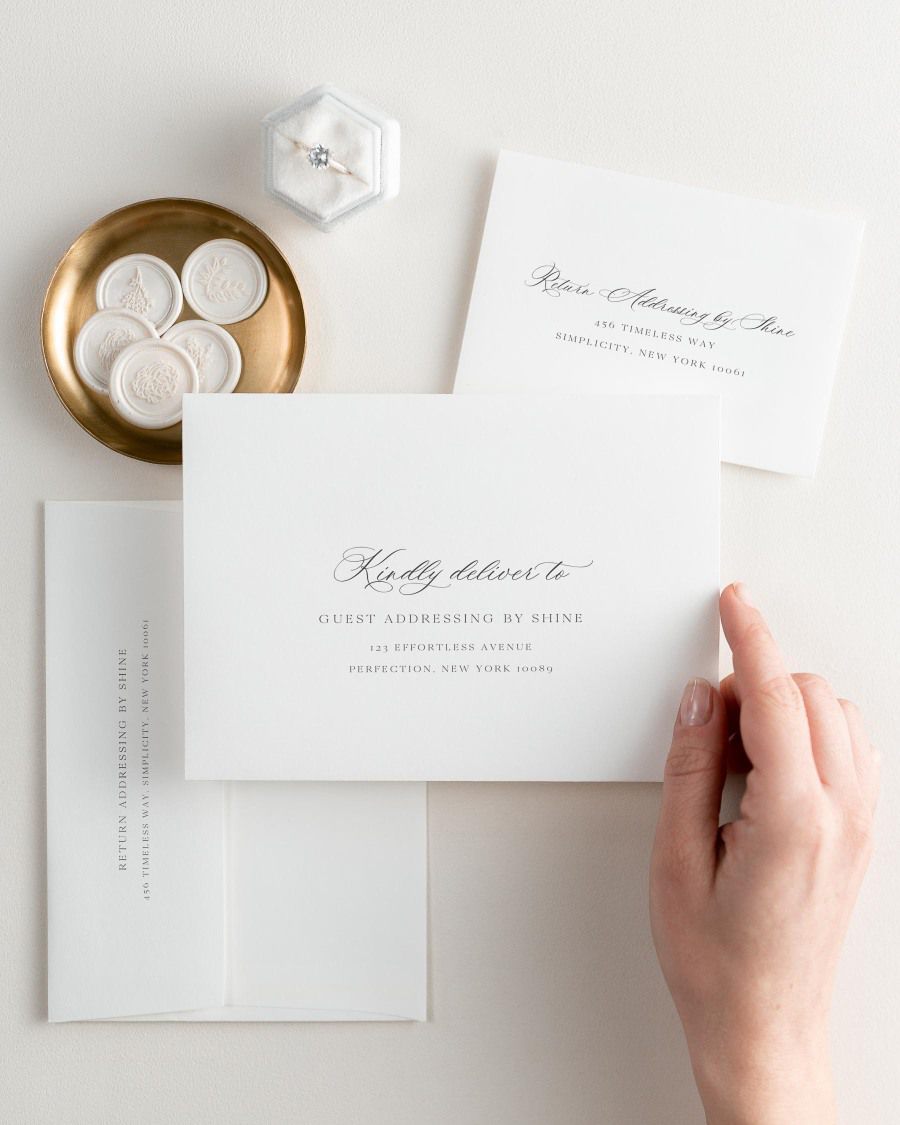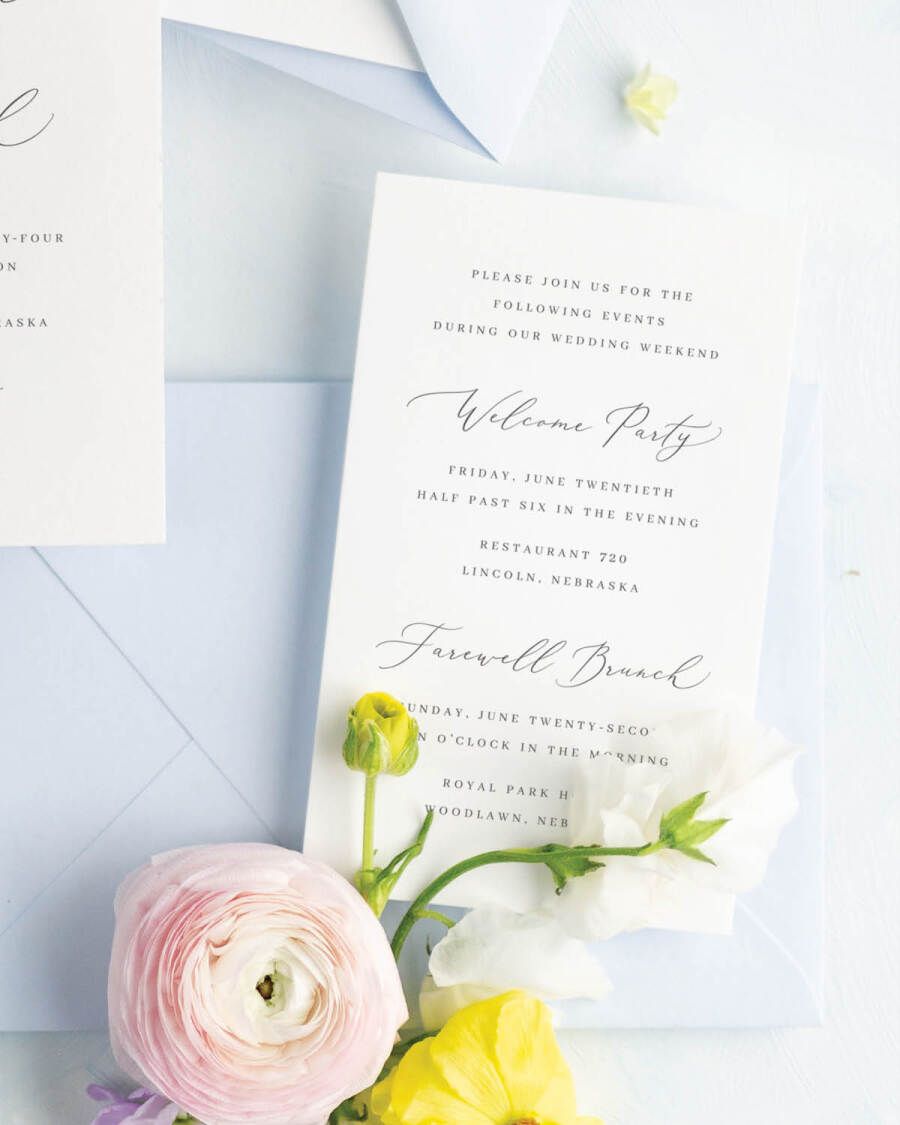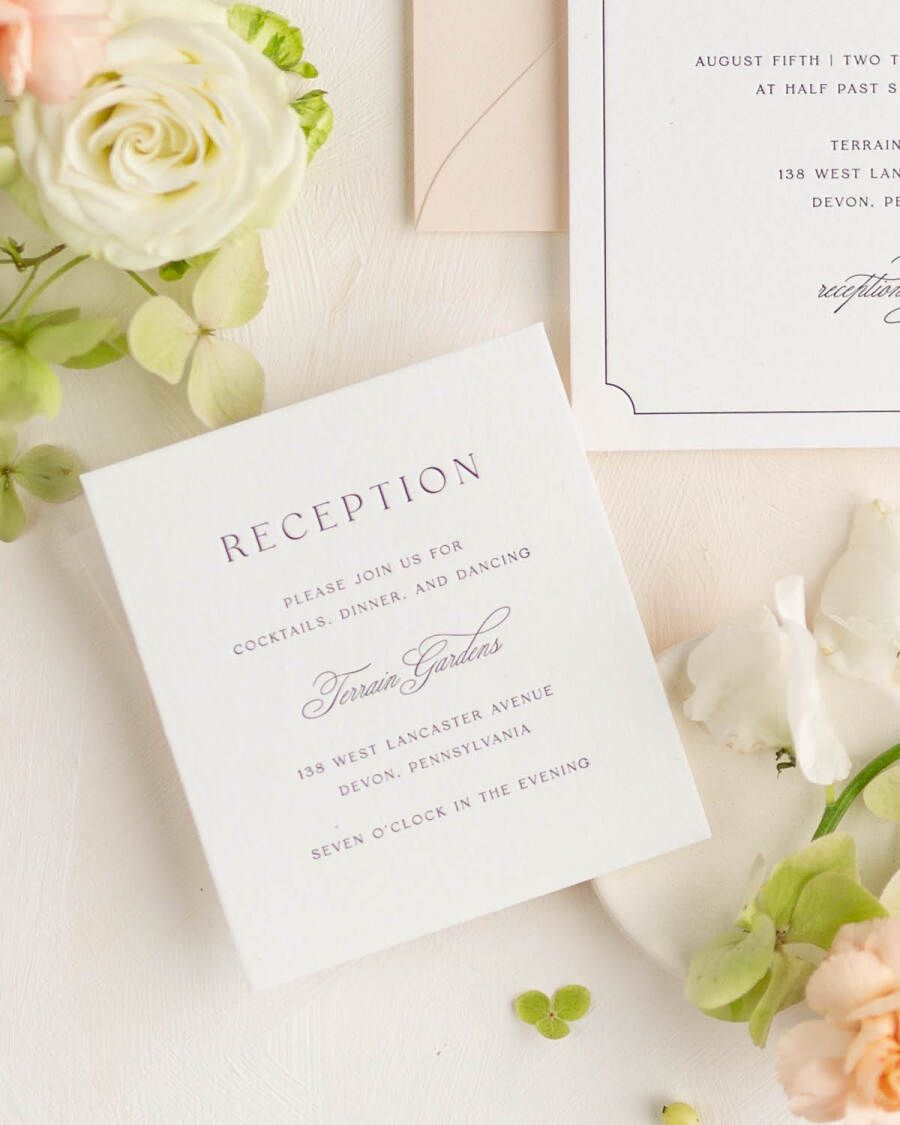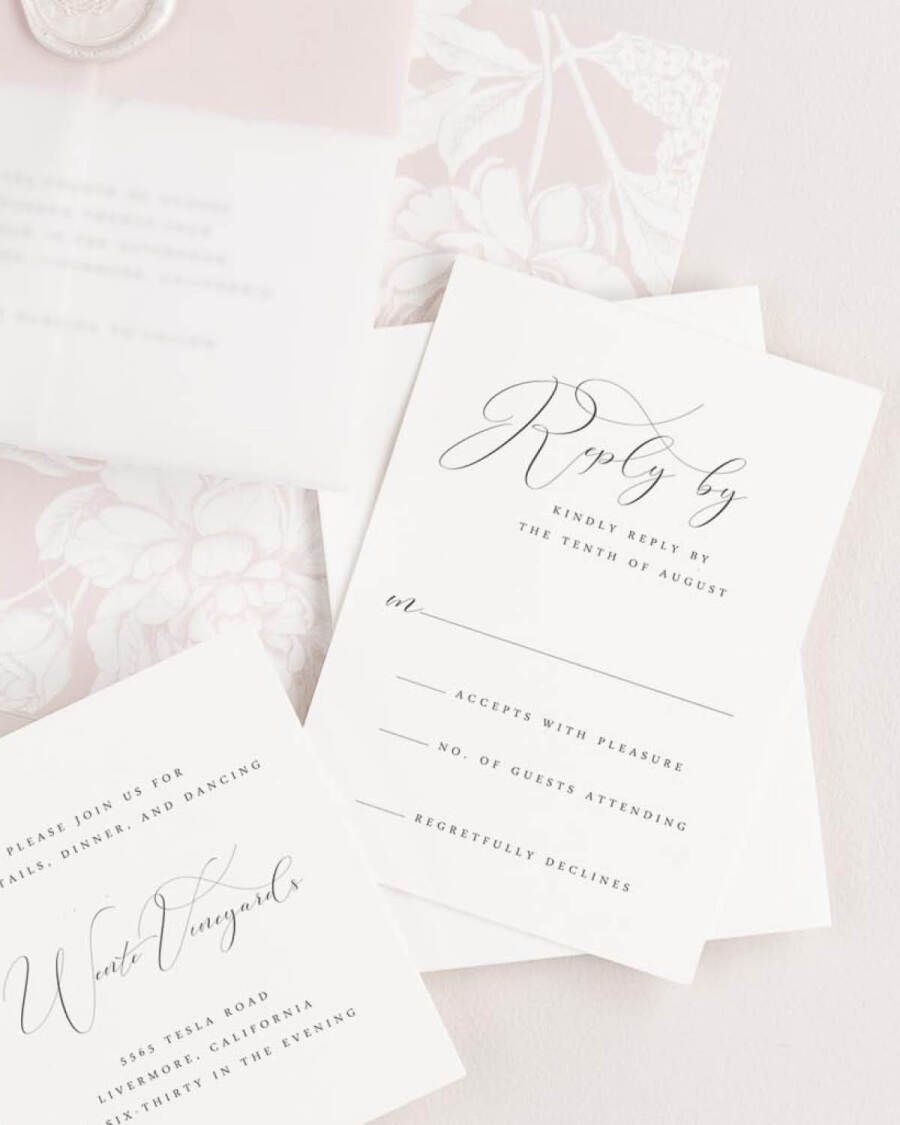Your wedding invitations are more than just a piece of paper—they're the official announcement of your celebration and set the tone for the day to come. While wording them might feel intimidating, there's a time-tested formula you can follow to make it simple, elegant, and uniquely yours.
Whether you're hosting a traditional black-tie event or a modern celebration with a twist, this guide will walk you through what to include on your wedding invitations and how to phrase it beautifully.
What Should Be Included on a Wedding Invitation?
Every formal wedding invitation should include the following key components:
- Host Line – Who is inviting the guests?
- Request Line – A polite invitation to attend
- Bride’s Name
- Groom’s Name
- Date and Time of the Ceremony
- Ceremony Location
- Reception Line (optional)
Enclosure cards are used for any additional information that doesn't fit on the main card. We'll cover that below.

Who's Hosting? How to Word the Host Line
Traditionally, the bride's parents are listed as the hosts because they were often the ones assuming most of the financial costs associated with the wedding. Today, many couples and their families make financial contributions, which can influence how the invitation is worded.
Here are several wording options based on who is hosting:
Example 1: Bride’s Parents Hosting
Dr. and Mrs. Robert Sloan
request the honor of your presence
at the marriage of their daughter
Example 2: Divorced Bride’s Parents Hosting
Dr. Robert Sloan
and
Mrs. Cynthia Hart
request the honor of your presence
at the marriage of their daughter
Example 3: Both Sets of Parents Hosting
Dr. and Mrs. Robert Sloan
along with
Mr. and Mrs. Thomas Martin
request the honor of your presence
at the marriage of their children
Example 4: Couple Hosting
The honor of your presence is requested
at the marriage celebration of
Designer Tip: If your hosting situation doesn't fit a standard format, take a look at our Wedding Invitation Wording Guide for more examples—or reach out to our team. We're here to help you get it just right.
Crafting the Request Line
The request line is your way of warmly inviting guests to your celebration. It should match the tone and formality of your event.
Here are a few timeless and tasteful variations:
- "request the pleasure of your company at the marriage of..."
- "cordially invite you to attend the wedding of..."
- "your presence is requested at the marriage celebration of..."
- "invite you to celebrate with them"
Designer Tip: “The honour of your presence” is traditionally used for ceremonies held in a place of worship. The British spelling “honour” is a sign of respect for the sacred setting, but “honor” can be used if you prefer. For ceremonies held elsewhere, “the pleasure of your company” is the more traditional choice.

How to List the Couple's Names
Etiquette states that the bride's name traditionally comes first, followed by the groom's name. Use full names (first, middle, and last) unless the last name is already mentioned with the parents.
Example 1: Bride’s Parents Hosting
Dr. and Mrs. Robert Sloan
request the honor of your presence
at the marriage of their daughter
Natalie Marie
to
James Christopher Martin
Example 2: Groom’s Parents Hosting
Mr. and Mrs. Thomas Martin
request the honor of your presence
at the marriage of
Natalie Marie Sloan
to their son
James Christopher
Example 3: Couple Hosting
Together with their families
Natalie Marie Sloan
and
James Christopher Martin
request the honor of your presence
at their marriage celebration
Designer Tip: Not sure whether to include middle names or titles? Our team can help you fine-tune every detail so your suite feels just right.
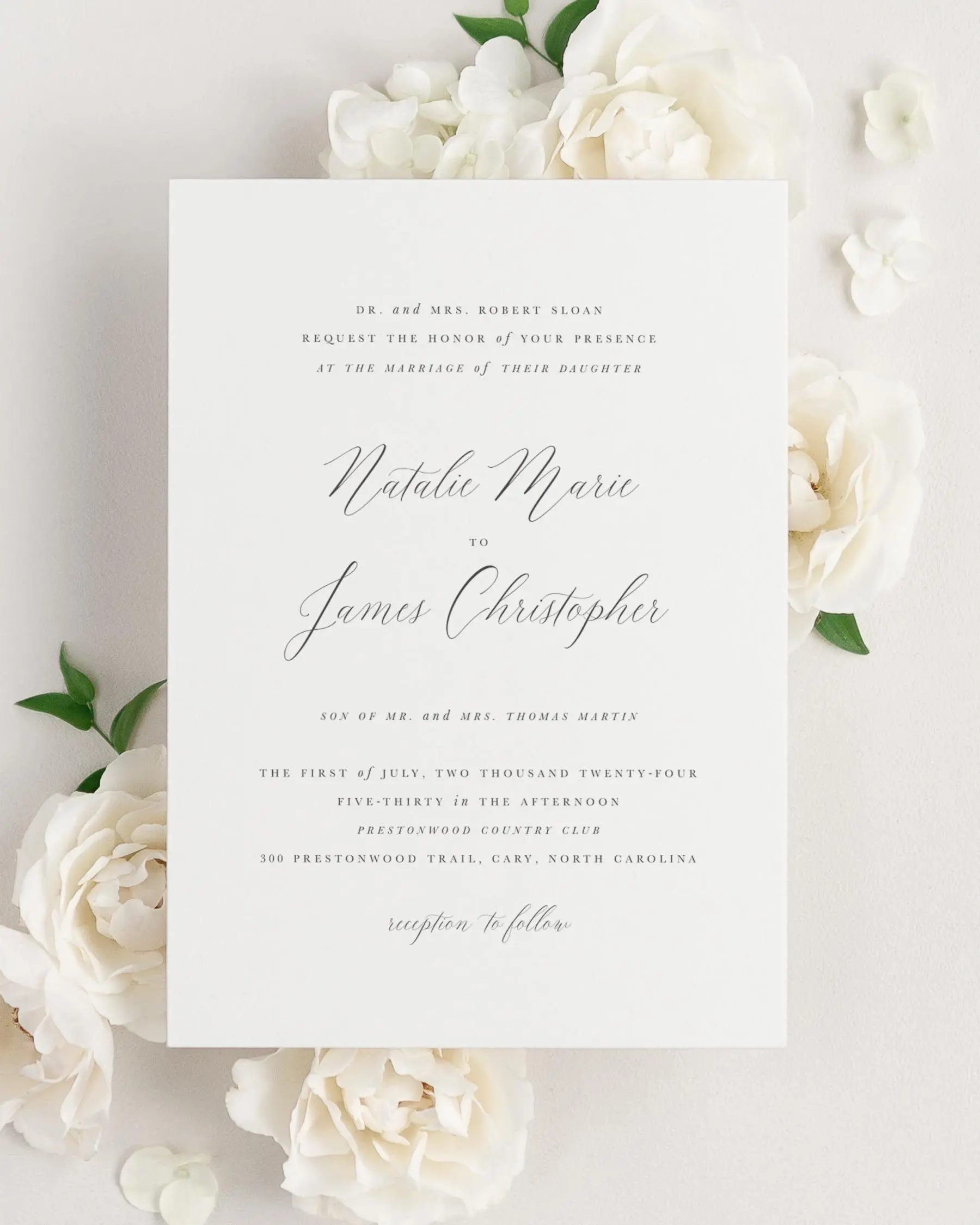
Choosing the Right Joining Word: “To” vs. “And”
The word that joins your names says a little something about the style of your invitation. For formal wedding ceremonies, especially when the invitation is issued by parents, the word “to” is traditionally used.
If the couple is hosting, or if the invitation is more modern or inclusive in tone, “and” is often preferred. It’s also commonly used for Jewish ceremonies, Nuptial Masses, and reception-only invitations.
How to Write the Date and Time
For formal wedding invitations, the date and time should be fully written out. Avoid numerals. Make sure to specify the time of day clearly.
Example 1:
Saturday, the tenth of May
two thousand twenty-five
at four o’clock in the afternoon
Example 2:
Saturday, May tenth
two thousand twenty-five
half past four in the afternoon
What to Include for the Ceremony Location
Keep your location details elegant and minimal. If the venue is well-known, the name, city, and state are usually sufficient, but a street address can be included if preferred. If your venue is a private residence, the street address is necessary. Zip codes are traditionally omitted from any addresses in the printed stationery.
Example 1: Recognizable Venue
Prestonwood Country Club
Cary, North Carolina
Example 2: Private Residence or Smaller Venue
The Sloan Residence
108 Willow Lane
Cary, North Carolina
Reception Line
A brief line like “Reception to follow” lets guests know to stay for the celebration. If your reception is at a separate location or doesn’t immediately follow the ceremony, omit the reception line from the main invitation, and include those details on a separate enclosure card.
Possible Options:
- Reception to follow
- Dinner and dancing to follow
- Merriment to follow
- Reception to immediately follow
- Cocktails, dinner, and dancing to follow
- Adult reception to follow
Where to Include the Dress Code on Your Wedding Invitation
If you're planning a formal or black-tie wedding, including the dress code is a thoughtful detail your guests will appreciate. The most traditional (and still widely accepted) placement is in the lower right-hand corner of the main invitation card—a subtle yet clear way to communicate expectations without adding extra wording.
For less formal events or if you’re including additional attire notes, you can place the dress code on an enclosure card instead, especially if space is tight or you prefer a cleaner look.
Designer Tip: If you're using a non-traditional dress code—like "garden party chic" or "elevated coastal"—we recommend listing example outfits or style inspiration on your wedding website. It's a helpful way to guide guests without adding extra detail to your invitation suite.
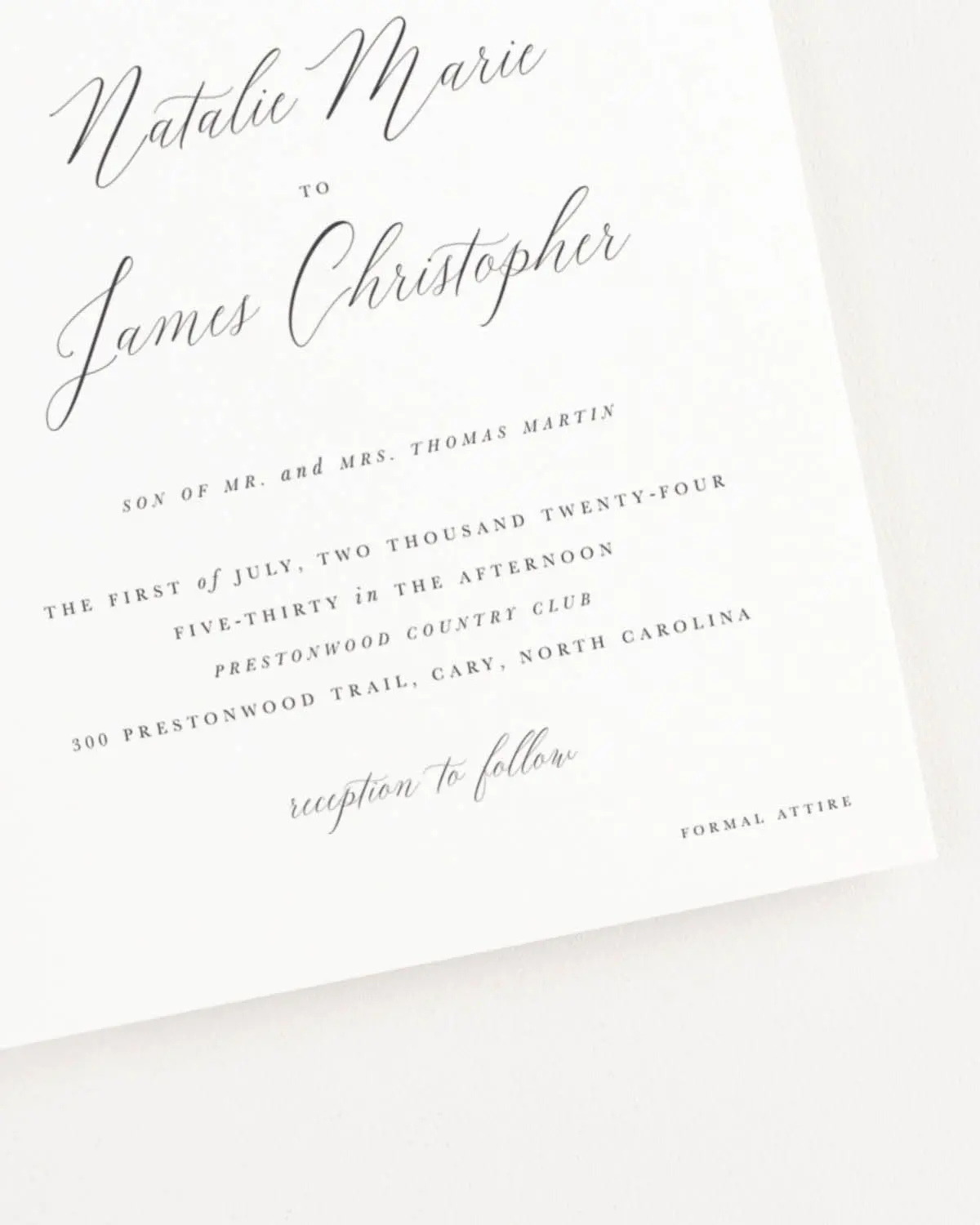
When to Use Enclosure Cards
If your wedding includes extra details, enclosure cards are the perfect place to share them. This keeps your main invitation clean and timeless while ensuring guests have all the information they need.
Common uses for enclosures:
- Reception location (if separate from ceremony)
- Wedding website details
- Travel and hotel accommodations
- Parking or shuttle instructions
- Additional wedding events (like the rehearsal dinner, welcome party, or farewell brunch)
Shine offers both large and small enclosure options to match your invitation suite perfectly.
Let Our Experts Handle the Wording
If this still feels overwhelming, you're not alone. Our guided wording process makes creating the perfect invitation effortless. Simply submit your wedding details during the ordering process, and our expert team will craft etiquette-approved, beautifully phrased wording tailored to your event.
You’ll receive a personalized proof with plenty of opportunities to review and make changes before final approval. It’s part of our Designed to Perfection Guarantee—because your invitations should feel just right, down to the very last word.

Wedding Invitation Wording FAQs
What is the correct order of information on a wedding invitation?
Start with the host line, followed by the request line, the couple’s names, the date and time, the ceremony location, and finally a reception note if applicable.
Do you have to include middle names on wedding invitations?
Middle names are optional. They add formality, but many couples choose to omit them for a simpler look.
Should we include our wedding website on the invitation?
It can be included if you’d like it to be, but traditionally, the wedding website would go on a separate enclosure card.
Can we include our registry on the wedding invitation?
It’s best to leave registry details off your wedding invitation. Traditionally, this information is considered a bit too transactional for formal wedding stationery. Instead, include your registry details on your wedding website, and share that website URL on a separate enclosure card.
Can I write the date using numbers?
For formal invitations, it’s most traditional to spell out the date and time in words, rather than using numerals. But, these are your invitations, so if you'd prefer to write the date in numbers for clarity, you certainly can!
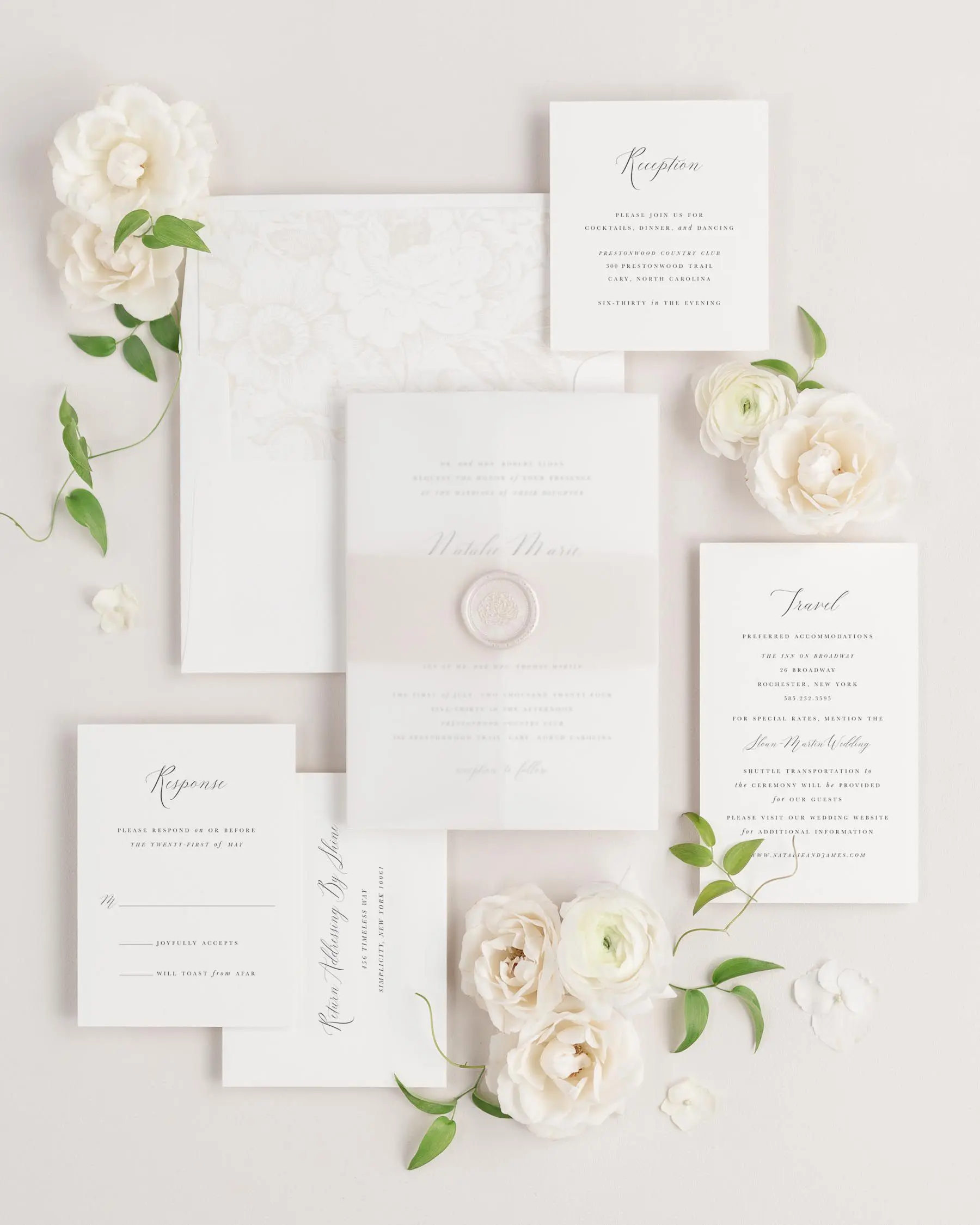
Your Next Step Toward a Timeless Invitation
Now that you know what to include on your wedding invitations and how to word them, you’re one step closer to a beautifully coordinated suite. Explore our full wedding invitation collection to see timeless designs in action, or take our styling quiz to discover the invitation suite that fits your vision best. Whether you’re drawn to something classic, modern, or romantic, we’ll help you bring it to life effortlessly.









Order a Custom Sample Set
Experience our papers, colors, and printing in person.
Not Sure Where to Start?
Take our styling quiz to find the right look and configuration for your stationery.
Bring Your Vision To Life
Browse our invitations and find the perfect design for your wedding.
A Difference You Can Feel
Make a statement with our luxurious letterpress wedding invitations
See Us Shine
Client visions brought to life #shinenewlywed



